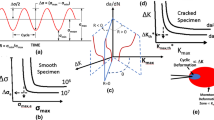Abstract
While various expected and accepted interpretations of the term “fatigue behavior” exist for homogeneous materials, especially metals, “fatigue behavior” of composite materials is not well defined—or understood. Generally speaking, one can discuss that topic by addressing the change in residual strength, life, and stiffness during cyclic (or otherwise variable) load histories. The present discussion will begin by defining the “problem” of fatigue behavior of composite materials, after which a representative spectrum of physical observations will be cited and models of the behavior presented. Both unnotched and notched behavior will be discussed. A brief section will deal with interpretations of data and statistical data handling schemes. Frontiers of the field will be identified. While the paper is presented in the spirit of a discussion of physical behavior rather than a review of the literature, representative work of numerous investigators is cited.
Résumé
Bien qu'il existe des interprétations variées et largement acceptées du terme de “comportement en fatigue” dans le das des matériaux homogènes, notamment les métaux, le comportement en fatigue des matériaux composites n'est pas bien défini voire compris. D'une manière générale, on peut aborder ce sujet en prenant en considération le changement de résistance résiduelle, la vie, et la rigidité au cours de Mistoire des contraintes cycliques ou tout du moins variables. La présente discussion commence à définir le “problème” du comportement en fatigue des matériaux composites suivant lequel un spectre représentatif d'observations physiques peut être invoqué et des modèles de comportement présentés. On discute le comportement à l'état non entaillé et à l'état entaillé. Un chapître spécial est relatif à l'interprétation des données et les schémas de traitement des données statistiques. Bien que le mémoire soit présenté dans l'esprit d'une discussion sur un comportement physique plutôt que dans 1'esprit d'une revue de la littérature, les travaux de nombreux chercheurs sont cités sous référence.
Similar content being viewed by others
References
A. Wohler, “Tests to Determine the Forces Acting on Railway Carriage Axles and the Capacity of Resistance of the Axles”, English Abstract Engineering, Vol. II (1871) 199.
K.L. Reifsnider and K. Lauraitis editors,Fatigue of Filamentary Composite Materials, American Society for Testing & Materials, Special Technical Publication No. 636 (1977).
W.W. Stinchcomb and K.L. Reifsnider, “Fatigue Damage Mechanisms in Composite Materials: A Review”, Proc. of Symposium on Basic Mechanisms of Fatigue, American Society for Testing and Materials, Kansas City, Missouri, May 24–25, 1978.
K.L. Reifsnider,Fatigue in Composite Materials, AGARD, Report No. 638, February, 1976.
S.G. Lekhnitskii,Anisotropic Plates, Translated from second Russian Edition by S.W. Tsai & T. Cheron, Gordon & Breach, Science Publishers, Inc., New York (1968) 157.
M. Kahl and K.L. Reifsnider,Engineering Fracture Mechanics, 4, (1972) 653.
P. Nair and K.L. Reifsnider, “Unsymmetric Deformation Fields in Symmetric-Geometry Specimens with Non-Uniform Properties”, Proceedings of Southeastern Conf. on Theoretical and Applied Mechanics, VII, Catholic University, Washington, D.C., March 21–22 (1974) 183–196.
K. L. Reifsnider and M. Kahl,International Journal of Mechanical Sciences, 16 (1974) 105–119.
R.F. McCartney, R.C. Richard and P.S. Trozzo,Transactions ASM, 60 (1967) 384.
C.C. Chamis and J.H. Sinclair,Experimental Mechanics, September (1977) 339–346.
Z. Hashin, D. Bagchi and W.B. Rosen,Non-Linear Behavior of Composite Materials, NASA CR-2313 (1974).
E.M. Wu, “Failure Analysis of Composites with Stress Gradients”, Proceedings of the US-USSR Seminar on Fracture of Composite Materials, Riga, USSR, September 4–7, 1978.
M.E. Waddoups, J.R. Eisenmann and B.E. Kaminski,Journal of Composite Materials, 5 (1971) 446–453.
J.M. Whitney and R.J. Nuismer,Journal of Composite Materials, 8 (July 1974) 253–265.
T.K. O'Brien, “An Evaluation of Stiffness Reduction as a Damage Parameter and Criterion for Fatigue Failure in Composite Materials”, Dissertation for the degree of Doctor of Philosophy in Engineering Science & Mechanics, School of Engineering, Virginia Polytechnic Institute & State University.
W.W. Stinchcomb, K.L. Reifsnider and P. Yeung,Investigation of Constraint Effects on Flaw Growth During Fatigue Loading of Composite Materials, Final Report, NASA Grant NSG-1364, NASA Langley Research Center (June 1979).
K.L. Reifsnider, E.G. Henneke, II and W.W. Stichcomb,Defect-Property Relationships in Composite Materials, AFML-TR-76-81, Final Report, Air Force Materials Laboratory, Wright Patterson AFB (June 1979).
K.W. Garrett and J.E. Bailey,Journal of Materials Sciences, 12 (1977) 157–168.
T.K. O'Brien and K.L. Reifsnider,Journal of Testing and Evaluation, 5, No. 5 (1977).
Author information
Authors and Affiliations
Rights and permissions
About this article
Cite this article
Reifsnider, K. Fatigue behavior of composite materials. Int J Fract 16, 563–583 (1980). https://doi.org/10.1007/BF02265218
Received:
Issue Date:
DOI: https://doi.org/10.1007/BF02265218




